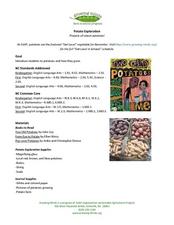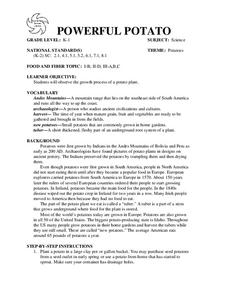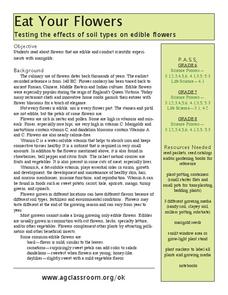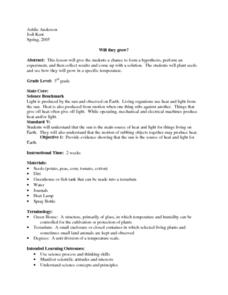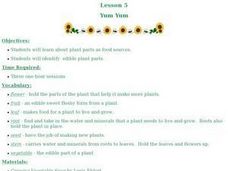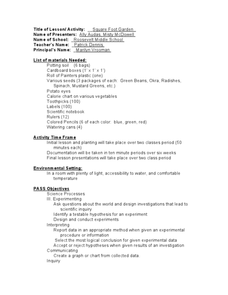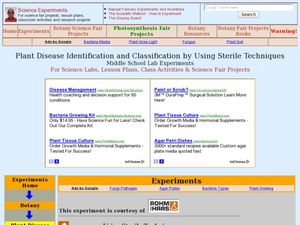Curated OER
Understanding How Potatoes Grow
Second graders make a KWL chart and brainstorm what they need for the project of growing potatoes. They choose one potato and plant it in water or peat moss cups and choose a location in which meets the needs of the plants and make their...
Growing Minds
Potato Exploration: Projects All About Potatoes!
How many potatoes tall are you? Unearth this rich resource! A reading of John Coy’s Two Old Potatoes begins a cross-curricular exploration of potatoes. Class members read, write, weigh, measure, and experiment with potatoes. Additional...
Curated OER
How Does Your Garden Grow?
Young gardners read and listen to books about seeds, plants, and the growing process. They plant seeds in plastic cups to observe the process of root-growing and plant formation. The whole class walks through a field to collect seeds...
Curated OER
Powerful Potato
Students are introduced to the growth process of a potato. As a class, they place a potato on a plate and observe how long it takes for the eyes to appear. In groups, they follow a recipe to make potato soup that is shared with the...
Curated OER
Growing Vegetable Soup
Students use children's literature in order to think about the concept of creating a garden. This is done through conducting simple research about types of plants that could be grown in the area and how to care for them. Then the garden...
Curated OER
Kitchen Garbage: Starting Sweet Potato Vines
In this sweet potato activity, students follow directions on how to grow a sweet potato and answer short answer questions. Students answer 2 short answer questions.
Curated OER
Box Cars Math Games
Students grow vegetable sections without soil, using water and pebbles or small rocks. They explain different ways that plants grow and grow vegetable sections using water and small rocks.
Curated OER
Where Do Your Veggies Grow?
Students examine the different ways fruits and vegetables are grown. In this vegetable growth lesson students are presented with the three ways that the vegetation occurs: leaves, roots, or branches. The students group pictures of the...
August House
The Ogre Bully
English language arts, math, science, dramatic arts, and cooking; this lesson has it all! For this multidisciplinary resource, your scholars will take part in a read aloud of The Ogre Bully by A.B. Hoffmire and have a grand...
Curated OER
POWERFUL POTATO
Students will observe the growth process of a potato plant.Plant a potato in a large clay pot or gallon bucket. You may purchase seed potatoes
from a seed outlet in early spring or use a potato from home that has started to sprout. Make...
Curated OER
Potato Head
Students create a potato looking object. In this art lesson, students decorate hamster bedding with a face making it look like the potato. Students water the object causing the grass to grow making it look like hair.
Curated OER
Where Do They Grow?
Learners complete worksheets. In this fruits and vegetables instructional activity, students complete a worksheet on where fruits and vegetables grow where they draw connecting lines. Learners color fruits and vegetables on a worksheet.
Curated OER
Using Sterile Techniques as a Tool in Studying Plant Diseases
Seventh graders examine the concept of sterile techniques. They realize that plant diseases can be identified and classified in various way. Students identify some of the diseases that attack the garden plants.
Curated OER
ESL: Tenses in Passive Voice
In this ESL passive voice tense worksheet, students fill in blanks in sentences, writing verbs in proper tense and passive voice.
Curated OER
Fun in the Sun
Students learn about safe summertime play and responsibility. In this Clifford-themed lesson plan, students read Clifford Keeps Cool, use a time line to discuss the story, and participate in a summertime picnic activity.
Curated OER
Eat Your Flowers
Students grow flowers in different soil mediums to determine the effect on flavor. In this investigative lesson students study flowers, plant them and taste them to see how they differ in different potting soils.
Curated OER
Participial Adjectives 2 -ed/-ing
In this participial adjectives worksheet, young scholars choose the correct way to complete the sentences with adjectives either ending in -ed or -ing. Students complete 16 sentences.
Curated OER
Will they grow?
Third graders plant seeds and see how they will grow in a specific temperature and are questioned about different environments and how they think crops would grow there. They form a hypothesis, perform an experiment, and then collect...
Curated OER
Asexual Reproduction
Presented clearly and accurately, this PowerPoint introduces biology learners to asexual reproduction in plants. It begins by comparing asexual to sexual reproduction by definition and by the pros and cons of each. The remaining slides...
Curated OER
Plants And Pollination
Learners describe sexual reproduction in plants, including the process of pollination, how insects assist in pollination, and how pollination differs from fertilization. They also explore the importance of honey bees to Arizona agriculture.
Curated OER
Yum Yum: Making Vegetable Soup
Young scholars investigate agriculture by reading a book. In this plant life lesson, students read the book Growing Vegetable Soup by Louis Ehlert, and examine the ingredients used in the book's soup. Young scholars create an...
Curated OER
Square Foot Garden
Students plant a garden and keep track of it. In this geometrical garden lesson, students collect data from their garden twice a week. They graph their finding and figure out how many square feet of growing space each person needs...
Curated OER
Plant Disease Identification and Classification by Using Sterile Techniques
Seventh graders identify how to use sterile techniques when identifying plant pathogens. In this plant diseases lesson students complete a lab activity in which they see how plant diseases are identified and classified.
Curated OER
SOIL
Second graders name the various materials that comprise soil, including weathered rock and other organic matter; and explain that soils differ in their color, texture, capacity to retain water, and ability to support the growth of many...



